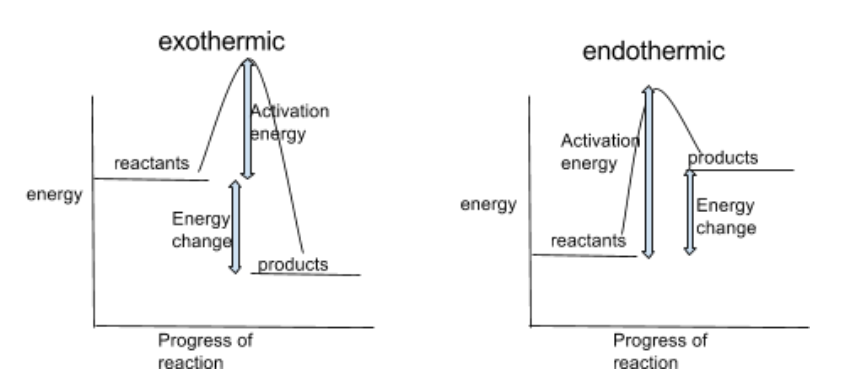UNIT 4 LESSON 5 – ENERGY CHANGES
5.1 Exothermic and Endothermic Reactions
Energy Transfer During Exothermic and Endothermic Reactions
When chemical reactions occur, energy is conserved.
The amount of energy in the universe at the beginning is the same as at the end.
This means if a reaction transfers energy to the surroundings, the product molecules must have less energy than the reactants, by the amount transferred.
Exothermic Reactions
An exothermic reaction is one that transfers energy to the surroundings so the temperature of the surroundings increases.
Product molecules must have less energy than the reactants, by the amount transferred.
Examples of exothermic reactions include: combustion, many oxidation reactions and neutralization.
Everyday examples of exothermic reactions include: self-heating cans (e.g for coffee) and hand warmers.
Endothermic Reactions
An endothermic reaction is one that takes in energy from the surroundings so the temperature of the surroundings decreases.
Product molecules must have more energy than reactants
Examples of endothermic reactions are thermal decomposition and the reaction of citric acid and sodium hydrogen carbonate.
Some sports injury packs are based on endothermic reactions.
Reaction Profiles
Chemical reactions can occur only when reacting particles collide with each other and with sufficient energy.
Activation energy = minimum amount of energy that particles must have to react.

Reaction profiles can be used to display the relative energies of reactants and products, as well as the activation energy and total energy change of a reaction.
You can tell which reaction is exothermic or endothermic by looking at whether the reactants or products have more energy (higher up energy scale = higher energy)
Exothermic: heat released to the surroundings, so products have less energy than reactants
Endothermic: heat taken in from surroundings, so products have more energy than reactants
The Energy Change of Reactions
During a chemical reaction:
Energy must be SUPPLIED to BREAK bonds in the reactants.
Energy is RELEASED when bonds in the products are FORMED.
The energy needed to break bonds and energy released when bonds are formed can both be calculated from bond energies.
Sum of energy taken in to break bonds – sum of energy released to form bonds = overall energy change
Energy taken in to break > energy released when formed = ENDOTHERMIC (because overall energy has been taken in)
Energy taken in to break < energy released when formed = EXOTHERMIC (because overall energy has been released)
5.2 Chemical Cells and Fuel Cells
Cells and Batteries
Cells contain chemicals which react to produce electricity.
The voltage produced by a cell is dependent upon a number of factors (e.g. type of electrode & electrolyte).
A simple cell can be made by connecting two different metals in contact with an electrolyte.
Batteries = two or more cells connected together in series to provide a greater voltage.
Non-rechargeable cells & batteries:
Chemical reactions stop when one of the reactants has been used up
Alkaline batteries are non-rechargeable
Rechargeable cells & batteries:
Can be recharged because the chemical reactions are reversed when an external electrical current is supplied
Fuel Cells
A fuel cell is a device that generates electricity by using a chemical reaction to convert fuel and oxygen into electricity, heat, and water. It’s like a battery, but instead of being charged up, it’s continually supplied with fuel and air to keep producing electricity.
Fuel cells work by using hydrogen and oxygen to produce an electrical current.
The hydrogen is fed into the anode (negative electrode) of the fuel cell and the oxygen is fed into the cathode (positive electrode).
The hydrogen atoms are separated into protons and electrons, which flow through the fuel cell to create an electrical current. The protons and electrons then combine with the oxygen at the cathode to form water.
Hydrogen fuel cells offer a potential alternative to rechargeable cells & batteries.
The following are the differences between hydrogen fuel cells and rechargeable cells and batteries:
Hydrogen Fuel Cell
Fuel cells can be used indefinitely as long as fuel is supplied.
Hydrogen is a gas so needs to be stored at high pressure and so is harder to transport.
Only produces water when burnt
Rechargeable Cells and Batteries
Can be recharged by reversing reaction, so fuel doesn’t need to keep being supplied.
Hard to dispose of because it is non-biodegradable
Will eventually stop working
Equations for each half cell:
At the anode (positive electrode):
H2(g) → 2e + 2H+(aq)
At the cathode (negative electrode):
4H+(aq) + O2(g) + 4e → 2H2O(g)